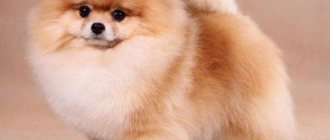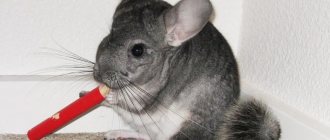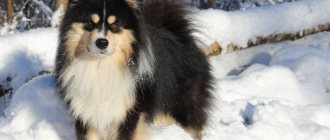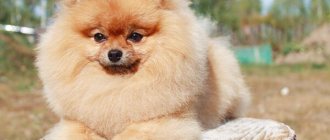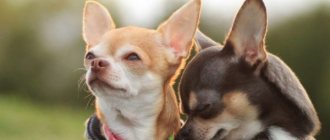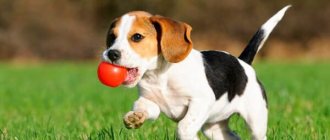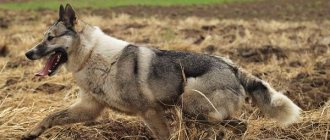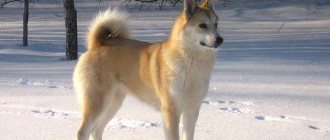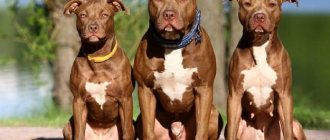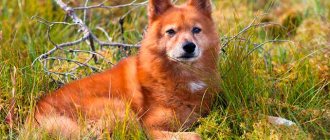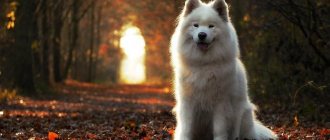a brief description of
| Aggressiveness |
| Upbringing |
| Training |
| Intelligence |
| Shedding |
| Behavior with children |
| Watchman |
| Security guard |
| Difficult to care for |
| Endurance in the cold |
| Endurance in the heat |
| Russia | |
| Lifespan | 10−12 years |
| Height male | 53–60 cm |
| Rising bitch | 48–58 cm |
| Weight male | 18-30 kg |
| Weight bitch | 18–30 kg |
Laika is a common and relatively new hunting dog breed in Russia. It is distinguished by unique, well-developed hearing, vision and sense of smell. Representatives of the breed are very beautiful in appearance, intelligent, well-mannered and friendly.
The breed belongs to group 5 “Spitz and primitive breeds” in the ICF classification. Some varieties, for example, the Yakut Laika, are still not recognized by the FCI.
Origin, history, creation
In ancient times, huskies were the name given to ordinary yard dogs living in almost every yard. They were called “yard dogs”, “northern pointy-eared dogs”, “pointy-eared dogs”. The Laika dog breed received its official name relatively recently.
The purpose of the breed has long been hunting. But if in the European part of Russia hunting was, for the most part, the prerogative of aristocrats who used hounds for this purpose, then for the peoples of the North and Siberia, fur fishing remained one of the main types of export trade. That is why increased demands were placed on hunting dogs, which the Laika met perfectly.
In the harsh conditions of the northern climate, dogs developed endurance, strength and other character traits, thanks to which they could bring real benefits to humans.
Interesting! Individuals that were considered useless and weak were not used by hunters for hunting and were destroyed, since it was not economically profitable to keep them. As they explored the North, newcomers brought dogs with them, and when mixed with them, the “witties” lost the purity of their blood, and with it their unique hunting qualities. Residents of the North also tried to eliminate the “half-breeds.” Now it seems cruel, but it was this method of breeding dogs that contributed to the emergence of a breed that is today considered one of the best in the world in terms of hunting characteristics.
Experts distinguish two periods of origin of the Laika breed. The first is the result of a hundred years of selection by hunters of the strongest dogs that hunt large animals, the second is the standardization of the breed, which began in the 20th century.
The first research and work on factory breeding with Ostroushkek began in the century before last. Active work began to promote this breed: publication of scientific research articles, publication of a separate book “The Laika and Hunting with It.” The first nurseries were formed, which contained the best representatives of this breed.
The Laika was approved as an official breed in 1925, and a few years later at the First All-Union Exhibition of Hunting Dogs, Laikas were very widely represented, which proved their enormous popularity among hunters.
Initially, huskies were classified into certain species according to the names of the peoples who bred them. Several ecotypes are known, each of which has certain features of appearance. At the end of the 30s of the last century, when cynologists identified Finno-Karelian, Karelian, Mansi, Khantei and Zyryan Laikas.
During the Great Patriotic War, the Laika dog was on the verge of extinction, so breeding work was interrupted, and the number of hunting dogs was significantly reduced. But they continued to be assistants to people: they were used as demolitions, mine-search dogs, messengers, ambulance dogs, and used to transport cargo and ammunition. Due to the fact that the country needed furs, the organization of nurseries was resumed.
Factory breeding required the creation of a new breed classification and a revision of existing breed standards. At the end of the 40s, cynologists decided to approve four temporary standards: Russian-European, Karelian-Finnish, West Siberian, East Siberian.
In the middle of the last century, breeding work was actively carried out, nurseries were created to improve the breed, but with the collapse of the USSR, the Laika dog began to degenerate. This was due to the closure of the kennel, when the best representatives of this breed ended up on the street, where they mixed with yard dogs.
Today the breed has become popular again. The following types of huskies are considered the most common:
- West Siberian;
- East Siberian;
- Russian-European;
- Norwegian;
- Swedish;
- Karelian-Finnish;
- Finnish.
In Russia and the CIS, the first three species are most often found.
Interesting! Some experts classify Siberian Huskies as the breed we are considering. The Laika Husky is a dog that was bred in Siberia by the Chukchi. It was used as a means of transportation - it, along with its relatives, was harnessed to a harness.
Trips with a husky to the dacha
The summer season is happiness for children and dogs: holidays, sun, river, no city dust. If you are a fan of growing vegetables, sunbathing on a sun lounger, or just spending time in nature, then your husky will be happy to accompany you everywhere. Most huskies are excellent swimmers and don't mind taking a dip in the water on a hot day. In addition, a beautiful, playful dog will likely be popular with local children, and they will take over some of your responsibilities for training the animal.
However, there are nuances that need to be taken into account when taking your dog to the country.
- Until the end of the vaccination quarantine, the puppy cannot be taken outside, even if you really want to (the dacha is considered a street), this is dangerous for his life.
- Laikas are temperamental and enthusiastic dogs, so before you let the animal run without a leash, make sure that it obeys you perfectly. Despite its good disposition, a husky can bark and greatly frighten a child (or even an adult).
- Don't let your husky run around unattended if you value your flower beds. A hunting dog can dig up an entire garden in search of voles in a matter of minutes.
- Take into account the tendency of huskies to escape (this is also important if the husky is constantly kept in a private house ). The excitement of the hunt and irrepressible energy sometimes play cruel jokes. Most often, huskies return without incident, but losing an animal is very scary, especially since someone else might offend it along the way.
- husky is kept in an apartment for 9 months a year , there is no need to put it in an enclosure at the dacha. Retraining an animal, changing its lifestyle for three months and then returning to old habits is painful and pointless for it.
Characteristics, description, character
For the Laika dog, a description of the breed was compiled back in 1939. But the standard was temporary; a permanent standard was approved in 1952.
- Distinctive features of huskies are their muscular body and strong skeleton. The height limit is 63 centimeters, for males - 52-58 cm, for females - 48-54 cm (on average).
- The coat is of medium length, thick, coarse, straight, with a soft and dense undercoat. The husky has a kind of collar on its neck, which is formed due to the fact that the hair on the shoulders and neck is thicker than on other parts of the body.
- The color is varied, most often mixed, white-gray or red.
The Laika breed has a freedom-loving and independent character, but at the same time very loyal.
- The breed is inquisitive, so if there is no leash, the husky can run far from its owner.
- Impeccable hunters and watchdogs, they show aggression only if they feel that their owner is in danger.
- They love attention and get along well with children.
- They are touchy, talkative, find it difficult to tolerate separation from loved ones, and cannot stand loneliness.
- They are indifferent to strangers.
- Likes are not characterized by servility or arrogance.
- What offends them most is injustice, which they will not tolerate even from their owners.
- They are fearless and quick-witted, capable of assessing a situation and making a decision, but the owner remains the leader in any situation.
- They are accommodating and flexible, but at the same time persistent.
- They love to play with people, run, jump, and always follow the owner’s commands. Even if the command is incorrect, the dog will still carry it out, although its instincts will tell it otherwise.
When hunting, they take on a leading role, clearly understanding why this or that action is needed. They give the owner the opportunity to make a well-aimed shot, diverting attention to himself. The husky does not hunt for itself - it is simply not interesting to it, it works for humans, and in the event of an unforeseen dangerous situation, it will sacrifice itself without hesitation.
How to clean your ears?
If you see dirt in your dog's ears or smell an unpleasant odor, it means it's time to clean his ears. To do this, position your pet so that its head is at the level of your hand. At the same time, fix the animal’s head with your left hand, and with your right hand, begin to clean the ears.
For cleaning, use a cotton swab and a special balm. First, use a cotton swab to remove plaque from the ear. Then take a clean swab, put a few drops of balm on it and wipe your pet's ear. Repeat this action 2-3 times.
Diseases
Laikas are distinguished by good health. This is due to the careful selection, because only physically strong dogs can benefit the hunter.
Among the most common diseases in huskies are:
- diabetes;
- renal failure;
- deafness
- glaucoma
- retinal atrophy;
- bloating;
- hip dysplasia.
Idiot's dream. Great dog, but not for a city apartment
Good day to all.
Since childhood, I dreamed of getting myself a puppy. I never wanted small pocket dogs, like Chihuahuas, etc. I have always liked big and massive dogs. But my parents were categorically against it, so for many years the dream remained unfulfilled.
It didn’t take long to decide on a name. They called it Ryksa. Loud and unusual. In honor of the Mazda RX-8. Car enthusiasts will understand =)
Ryksa cried for a couple of days after arriving at her new home. She cried all day and night and calmed down only when they put her on her knees and rubbed her tummy, fortunately her size at one month old allowed this to be done.
For the first 2 months, Ryksa and I lived in perfect harmony. We walked for a long time and actively, went outside the city, ran through the fields, took photographs.
With the age of 6 months, the worries and troubles increased. Let's go through each point in detail.
For me, most of these disadvantages were insignificant, and they did not prevent me from noticing and enjoying the advantages of Ryska and her breed as a whole. Namely:
4. Health. I don’t fully understand, either this is the breed itself, or we were very lucky with Lynx, but in a year and a half she hasn’t suffered from a single sore. Seriously, we managed to avoid even the mildest diseases, although as I already said, we practically live on the street and have very close contact with the outside world, nature and other animals.
5. Strength and endurance. For the sake of interest and of course not to the detriment of Ryska in the winter, we harnessed her to a sled. She rolled 70 kg of live weight around the yard with ease and joy. I wonder how long she can push a small child on a sled? =)
Conclusion.
I kindly ask you to consider if.
That's all. Happiness to you and your pets, take care of them.
Source
Care and maintenance
Caring for a husky does not present any particular problems. They are not gluttonous, not demanding, adapted to harsh climates, and clean.
- The ideal conditions for keeping are an enclosure where the dog will feel comfortable.
- Living in an apartment or urban environment is not advisable for a husky - it needs to be walked a lot. Without walks, the dog will get bored and begin to suffer from a confined space, so the owner must provide his pet with a long and interesting walk.
However, this breed is too independent. When walking, huskies try to run away from their owner, actively get to know other dogs and cats, so they very often die under the wheels of vehicles or disappear.
If the owner is not a hunter, then it is better not to get a puppy of this breed. Laikas, by their nature, cannot become “sofa dogs.” They must work, that is, hunt, they need a trade.
The best habitat for huskies is the northern regions of the country, as the heat can have a detrimental effect on the health of the pet.
Features of care include:
- Brush the coat once a week during the shedding period.
- Bathing only when necessary, as frequent water treatments can damage the unique structure of the coat and wash away its natural oils.
- Wiping the eyes as a preventative measure with a damp cloth.
- Regular examination and cleaning of ears from wax.
- Inspect paws for splinters and abrasions.
When it comes to feeding, huskies are unpretentious and can go without food for a long time. If the dog is fed dry food, then preference should be given to a composition with a high content of proteins and fats.
If the dog is supposed to be fed natural food, then the diet should include meat (beef), sea fish (boiled, boneless), cereals (oatmeal, rice, buckwheat), vegetables (pumpkin, carrots, raw zucchini), fermented milk products . To strengthen teeth and replenish the lack of mineral salts, it is recommended to give bones and tendons.
It is not recommended to feed your husky with minced meat, legumes, flour and sweet foods - their consumption can negatively affect the functioning of the gastrointestinal tract.
How to bathe properly?
The Samoyed does not need frequent bathing, as it does not have a specific odor. In addition, their wool has the property of self-cleaning. Therefore, your pet should be bathed no more than 3-4 times a year.
If your dog needs to be washed, follow these rules:
- You should not bathe your Samoyed until he is 3 months old.
- The water temperature for swimming should be approximately 37–38 degrees.
- First of all, the dog needs to be thoroughly wetted with water and soaped, since the Samoyed’s fur is very thick. This procedure will take quite a long time.
- The pet's head is washed last.
- Use shampoo for white, double-coated dogs when bathing.
- After applying the shampoo, rinse the animal thoroughly so that no shampoo particles remain on the fur.
- Wrap the Samoyed in a large towel, gently blot the coat and dry with a hairdryer.
IMPORTANT!
During and after bathing, be sure to praise your dog and talk to him gently.
Education and training
Laikas are very smart and quick-witted, but they do not like to learn, so a number of problems may arise during the training process. Success can be achieved only if the animal recognizes its owner as a leader, and only if it strictly follows commands.
Some breeders are sure that huskies are stupid, capricious dogs. However, this belief is characteristic only of inexperienced animal owners. The difficulty of training is not associated with the laziness or stupidity of dogs, but with their independence and highly developed sense of self-esteem. Teaching a student will require a lot of patience and certain skills.
A lot of time should be devoted to training; classes should be alternated with games and rewards, for example, processed cheese, which huskies love very much.
Representatives of this breed perfectly understand the intonation of the voice, so if you constantly raise your voice at her, they will perceive it as an insult. Under no circumstances should you use force or punish your pet - they do not tolerate cruelty towards themselves. The owner's rude behavior can contribute to the formation of aggression and anger in the dog.
From a very early age, the puppy must understand basic commands, know his place and understand what he can and cannot do.
Proper training of a dog will make it a loyal friend and reliable protector of all family members.
Personal place
A dog’s personal place is its territory, a cozy corner in which it can relax.
To make your pet comfortable, follow these rules:
- The dog's place should be bright, warm and cozy. Under no circumstances should it be in a draft or passageway.
- Also, do not place it near radiators, heating devices, or in the bathroom.
- The best place for a dog is the entrance to the owner's bedroom or the bedroom itself. This place smells like the owner, his things are here, and for the dog this is the most important thing.
Puppies
Choosing a pet is not an easy task, since the husky is a whole group of breeds with significant differences. First you need to decide for what purpose you are getting a dog. If an attractive exterior is a priority for the owner, then you should choose a puppy based on its external characteristics.
If a husky puppy is purchased for hunting, then appearance alone is not enough. Without skills in the basics of dog breeding and knowledge of the peculiarities of keeping the breed, it will not be easy to manage huskies, since they are distinguished by their freedom-loving character and independence. This breed is absolutely not suitable for homebodies, opponents of hunting and lovers of silence.
There are often cases when a person who does not have training skills acquires an adult dog. This is not recommended. Laikas are monogamous people who remain devoted to their first owner until the end of their lives; they will not be able to accept the new owner and will not obey him.
The best option for choosing a puppy is to contact practicing hunters or a well-known nursery, where the future owner is required to show the documents for the puppy and the working diplomas of the parents.
The decisive factor in the choice is the character of the student. A Laika puppy should be cheerful, playful and healthy. It is better for a hunter to choose a medium-sized puppy. You can take your pet home at the age of one and a half months.
How to trim claws?
It is believed that Samoyeds do not need to trim their nails, since they grind them down on their own. But it is not so.
Even if the claws have ground down on the asphalt, they all need to be filed early to prevent cracking. In addition, the claws on the side toes do not always grind down and often interfere with the pet’s walking.
How to trim nails correctly:
- Sit on a chair and place your pet in front of you.
- Grab your dog's paw firmly but not harshly, place the tip of the nail into the nail clipper and trim in one go.
- If the dog reacts calmly, you can move on to the next nail. If your pet is nervous, calm him down or postpone grooming.
- Try to carry out the procedure when the dog is calm and in a good mood.
- A hemostatic agent should be prepared in advance. This could be baby powder, food starch or flour.
Prices
The price for the Laika breed is low. Even a purebred husky can be purchased at a price lower than that of representatives of other hunting breeds, however, you should only purchase a puppy from trusted breeders.
The price for a baby without a metric can range from 5,000 to 7,000 rubles. This is an excellent option for people who do not plan to breed the breed or exhibit them at Russian or international exhibitions.
A top-class purebred husky costs from 10,000 rubles and above. However, such a high price is determined not only by the exterior, which is as close as possible to the ideal and the purity of the pedigree, but also by the merits of the manufacturer and the fame of the nursery.
So how much does a like cost? The cost of an adult hunting husky depends on the size of the animal it can hunt. Compare:
- “squirrel breeds” from trusted breeders cost 5000-7000,
- “sablehouses” – 7000-9000,
- large game hunters – from 10,000 rubles.
Kennels sell vaccinated and healthy puppies with good pedigree, from working champion parents. However, for many future owners, purebred is not important, so they turn to private sellers, whose puppies are much cheaper. For this reason, there are not many nurseries specializing in breeding huskies.
Exhibition career
If you plan to get offspring from your husky , you will have to visit at least one certified exhibition and go through the grading - a comprehensive assessment of the animal’s compliance with the breed standard. Everything will be taken into account:
- exterior;
- origin;
- quality of offspring (if you already have one);
- work qualities and character.
Preparing for an exhibition is not the easiest task. You will need:
- take care of your pet’s excellent appearance;
- teach him to stand upright, show his teeth, and react with dignity to the presence of strangers.
You can't be born a champion. Even puppies rated as potential show and breeding class may not live up to expectations. Laika can only be raised , and raised with an eye toward future competitions.
Photo
In this article you got acquainted with the amazing Laika breed, photos of which are presented in the gallery above. A hardy hunter, a devoted friend and companion, this dog is able to grace any owner with its daily presence.
Breed Features
Known for their amazing performance and beautiful appearance, affectionate and loyal nature, huskies are a very popular choice, both as a pet and as a helper. They are athletic, smart, resilient and energetic. They love to be in the company of other huskies. They have a double coat and thick fur, perky ears and a unique color.
Breed varieties
The main, most common types of huskies:
- Russian-European Laika;
- West Siberian Laika;
- East Siberian Laika;
- Karelian-Finnish Laika;
- Finnish Spitz;
- Yakut Laika;
- Norwegian gray elk husky;
- Karelian bear husky.
Appearance
Consider the Siberian Laika, a very attractive dog that is known for its resemblance to a wolf. They are medium in size, with males slightly heavier and larger than females.
Height at withers/weight:
- males 53 - 61 cm, 20 - 27 kg;
- females 51 - 56 cm, 16 - 23 kg.
The proportions of their head are harmonious in relation to the rest of the body. Their skull is slightly domed and their muzzle is moderately long and wide, tapering towards the nose (which can be black, brown, or flesh-colored, depending on the dog's coat color).
The eyes are almond-shaped and can be blue or brown. This breed often has a sharp, focused gaze, and is also often mischievous and friendly.
The ears are medium in size and close set, positioned high on the dog's head. They are triangular in shape, slightly wider at the base, and held very straight. Fleshy, well covered with hair and have slightly rounded tips. Laikas have strong jaws with a perfect scissor bite, with the upper teeth neatly overlapping the lower teeth.
The neck is moderately long and powerful, the shoulders are well laid back, the front legs are muscular and straight. Their bodies are strong, have a broad chest with well-arched ribs, and always with well-developed muscles. Powerful hind legs - thanks to the developed upper thighs. Paws with small membranes between the toes, compact, oval-shaped, medium in size, well protected by fur. The tail is well covered with hair and is very reminiscent of a fox's tail.
The Laika has a thick, medium-length coat that lies close to the dog's body, with an undercoat that is thicker and softer than the outer coat.
Character
Laika is delighted to be in the company of people and sincerely enjoys their company. She forms very close social bonds with her owners. Gets along well with children and enjoys playing with them. She is very devoted and submissive to her owners, in extreme situations she is ready to sacrifice her life to save her guardian.
The habits of dogs of this breed are similar to almost all others (yelping, scratching, yawning, barking). If the husky is hungry or sick, it will howl or scream. They boast a very strong hunting instinct, which can become unsafe for small pets, including cats.
The Laika is known to love the sound of its own voice and can be very noisy at times with howling dogs.
They are very hardy, strong, and do not feel the cold thanks to their thick double “fur coat.” They need an abundance of mental stimulation and exercise to become a well-balanced dog.
If you leave your pet alone for any length of time, you will soon notice that the dog is bored and develops some unwanted behavioral problems, namely: excessive howling and the desire for various sabotage. Laika is a harmlessly cunning dog, athletic and flexible, so skillfully leaving the enclosure or any barriers will not be difficult for her. The most reliable and high barriers may also not stop the husky; they are very good at digging under the fence.
Since these dogs have a brilliant mind, this can make the training and training process somewhat difficult. They are a good choice for people who are familiar with this type of dog, but not for the first-time owner.
Photo gallery
Let's look at photographs of these freedom-loving dogs, who are accustomed to running for many kilometers and require space when keeping them. But nevertheless, a comfortable existence of these animals is possible even in urban conditions.
